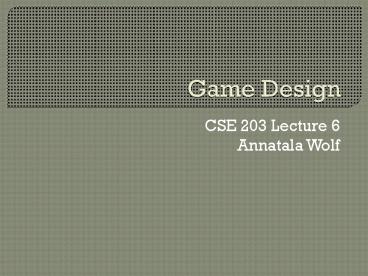Game Design - PowerPoint PPT Presentation
1 / 16
Title:
Game Design
Description:
Strategy: puzzle games, strategic combat ... side-scroller, platformer, first-person shooter, puzzle (Tetris), fighting ... Games will be graded on originality, ... – PowerPoint PPT presentation
Number of Views:513
Avg rating:3.0/5.0
Title: Game Design
1
Game Design
- CSE 203 Lecture 6
- Annatala Wolf
2
Constructors
- If you use classes in your design, you may want
to use constructors. A constructor is an
operation that automatically runs when an object
is created. - To call a constructor, you use the phrase New
Type(args go here) - You can think of the constructor as a function
that returns a Type object.
3
Constructor Example
- Class Dude
- Private Define name As Text
- Constructor(name As Text)
- This.name name
- End Constructor
- End Class
- Method Main()
- // Make a Dude object and set its name
- Define fred As Dude New Dude(Fred)
- End Method
4
Default Constructor
- In Phrogram, all classes have a default (empty)
constructor, even if you dont define one. If
you dont call a constructor, it will call the
default one for you when you make the object. - // Calls default Constructor()
- // for Sprite class!
- Define jumper As Sprite
5
New Objects
- Every time you call a constructor, you get a new
object. So this resets the objectyoull lose
anything you did with it before. - // Calls Foos Constructor()
- Define blather As Foo
- // Overwrites blather
- blather New Foo(stuff, 12)
- // Overwrites blather again
- blather New Foo()
6
Dont Get Lost!
- If you have difficulty getting classes to
workremember, you dont need to use them for
your project. - You should, however, understand how to separate
your code into operations. Your Main() method
should be relatively clean and short, and most of
the variables you use should be at the program
level.
7
Kinds of Projects
- Your project will probably be a game of some
sort. This is partly because Phrogram lends
itself well to game programming. - Non-game projects are also possible. You could
write a simulation, a tool, or an application.
But it should be tricky to implement, and
interesting!
8
Game Genres
- Strategy puzzle games, strategic combat
- Action side-scroller, platformer, first-person
shooter, puzzle (Tetris), fighting - Roleplay/RPG usually with epic plot, multiple
characters, character growth - Adventure mix of action and RPG
- Sports sports, card games, driving
- Simulation usually resource management
9
Planning the Game
- Game design begins with a concept. What do you
want the game to be like for the player? - Generally, there will be a set of different
situations a player can be presented with. - There may be multiple levels to complete
- There might be menu windows that pop up
- There could be different modes of play
- There might be choices before the game starts
10
Game State
- With all these different things going on, how can
you keep track of what the program is supposed to
do? - The idea of game state encompasses not only the
data the game has access to and where the code is
running, but also what mode the game is in. - We can use variables to remember what state the
game is in.
11
Constants
- Sometimes, youll want to use a variable to refer
to the same value over and over again, without
ever changing. This kind of variable is called a
constant. - Constants are useful for remembering constant
values (like PI 3.14159), or state labels
(NORTH 1, EAST 2, etc.)
12
Defining Constants
- To define constants, use the keyword Constant
(instead of Define). You need to assign them
when you create them. - Constant PI As Decimal 3.1416
- Constant MAIN_MENU As Integer 2
- Note that constant values are traditionally
written in ALL_CAPS.
13
Using Constants
- Constants are used just like variables, but they
cant be reassigned. (You can even make them
private class members if you want to use them
only in that class.) - area PI radius radius
- MAIN_MENU 3 // error! constant
14
Back To State
- Consider a game that starts with a character
creation screen, then toggles between a map
screen and a combat screen. How would we keep
track of it? - At the program level, well make
- Constant GS_CREATE As Integer 1
- Constant GS_MAP As Integer 2
- Constant GS_COMBAT As Integer 3
15
Testing For State
- We can segregate each mode of the game into a
separate operation, for simplicity. Well call
these from the main event loop. - While (Not gameOver)
- If (gameState GS_CREATE) Then
- charCreation()
- Else If (gameState GS_MAP) Then
- mapScreen()
- Else If (gameState GS_COMBAT) Then
- combatScreen()
- End If
- Delay(refreshRate)
- RefreshScreen()
- End While
16
Aiming For The Moon
- Part of the project proposal process is deciding
how much you want to tackle. - Games will be graded on originality, fun, and
difficulty. But some things are too difficult to
complete in four weeks. - Solution aim for something hard, that you can
scale back if necessary. ?































